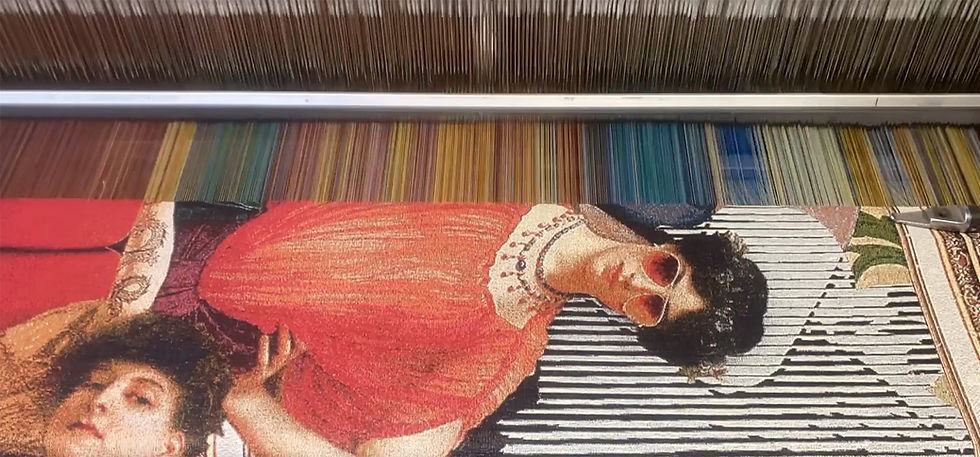How to Make and Price Woven Commissions
- logan bates
- Aug 5, 2024
- 4 min read
Today, many companies and organizations often look for eye-catching, long-lasting art for their offices, buildings, or galleries. As an artist, making custom-woven pieces for your clients, including individuals and large organizations, can be an exciting and rewarding experience. Moreover, custom woven murals and displays are not very common, which makes them special. This rarity gives you a unique selling point when approaching potential clients. But how do you price your work when creating a premium tangible item?
Whether you're creating a small tapestry or a large mural, understanding how to price your work fairly and find good opportunities is key to success. In this article, we will guide you through the process of making and pricing woven commissions, with a focus on creating murals for companies and organizations. By offering unique custom woven pieces, you can provide these clients with something truly special and timeless that will stand out and impress their visitors for years to come.

Understand Your Market
Before you start looking for commissions, it's important to understand who might want your work. Companies and organizations are often your best bet for large-scale woven pieces. They might want art for their lobbies, meeting rooms, or public spaces. Galleries might also be interested in displaying or selling your work. Think about the kinds of places that would benefit from a beautiful, unique woven piece. Also, you should not limit your market to your local area.
Showcase Your Skills
To get commissions, you need to show potential clients what you can do. Build a strong portfolio that shows off your best work. Include various art pieces to demonstrate your range of skills. Take high-quality photos of your work and create a website or social media account to display them. If you've done any previous commissions, make sure to include these and explain a bit about the project. Don't be afraid to show your process, too - many clients are fascinated by how woven pieces are made.
Price Your Work Fairly
Pricing your work can be tricky, but you also need to get it right. Calculate your material costs, such as yarn and any other supplies you need. Then, figure out how long it takes you to make a piece. Decide on an hourly rate for your time and skills. Don't undervalue yourself - remember, you're offering a premium, handmade product. Add these costs together for your base price. For custom work, you should also include an extra fee for the unique design.
Find Opportunities
To get commissions, you need to put yourself out there. Start by reaching out to local businesses, organizations, and galleries. Attend art fairs and craft shows to meet potential clients and other artists. You can also use social media to showcase your work and join online artist communities. You could also partner with interior designers or architects who might recommend your work to their clients.
Make Your Pitch
When you have a potential client, you need to convince them that your work is worth their investment. Explain what makes woven art special - its texture, durability, timelessness, and uniqueness. Show examples of your past work and describe how you could create something specifically for their space. Also, you should explain your process and tell them how long it will take to deliver the artwork and what you need from them.
Draft a Commission Agreement
Once a client is interested, you need to have a clear agreement. The contract should include the size and design of the piece, the materials you'll use, the timeline for completion, and the price. Also, specify when payments are due – you can ask for a deposit upfront. Include details about any revisions or changes the client can request and what happens if either party needs to cancel the agreement. Having everything in writing helps prevent misunderstandings and protects both you and your client.
Work on the Commission
When you start working on the commission, keep your client involved in the process. Send them sketches or small samples for approval before you begin the full piece. Keep them updated on your progress, especially if you're working on a large piece that will take a while to complete. If you run into any problems or delays, let them know as soon as possible. Remember, good communication is key to a successful commission and can lead to repeat business or referrals.
Deliver and Install the Piece
When your woven piece is complete, make sure you present it professionally. If you're delivering it in person, transport it safely. If you're shipping it, pack it carefully to prevent damage. For large pieces, you might need to install it yourself or work with a professional installer. This is your chance to make a great final impression, so take the time to make sure everything is perfect.
Follow Up and Build Relationships
After you've delivered the piece, follow up with your client to make sure they're happy with it. Ask for feedback and, if they're pleased, request a testimonial or review. This can help you attract future clients and secure more commissions. Consider offering maintenance or cleaning services to keep the piece looking its best. Stay in touch with your clients - they might want more pieces in the future or recommend you to others.
Conclusion
Creating and pricing woven commissions requires a blend of artistic skill and business sense. By understanding your market, showcasing your skills effectively, and pricing your work fairly, you can turn your passion for weaving into a successful business. Most importantly, each commission is an opportunity for you to create beautiful art pieces and timeless woven artwork, build relationships, and grow your reputation as an artist. If you would like to know more on how to create your own woven commissions, contact our artist liaison team any time at info@fiberart.com.



Comments